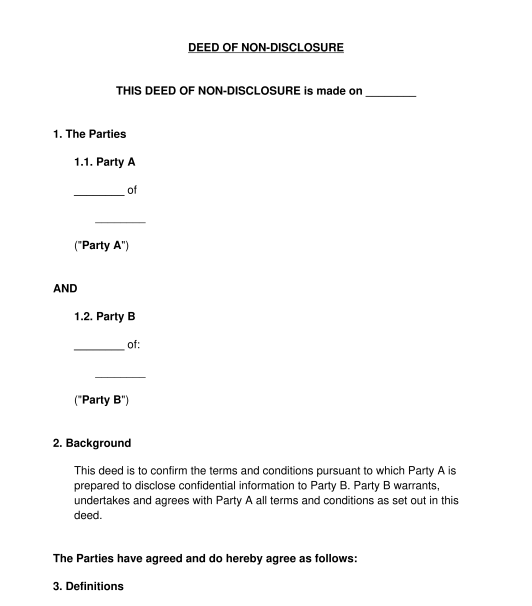 07/09/2025
07/09/2025

Answer a few questions and your document is created automatically.

Your document is ready! You will receive it in Word and PDF formats. You will be able to modify it.

 07/09/2025
07/09/2025
 Word and PDF
Word and PDF
 3 to 5 pages
3 to 5 pages
A non-disclosure agreement (often referred to as an NDA or a confidentiality agreement) protects confidential information that has been disclosed between two parties. It creates enforceable obligations between the parties, namely that they will not disclose or use any confidential information to third parties for any purpose other than that set out in the agreement.
A non-disclosure agreement may be used in a number of different settings, including in an employment setting or alongside a business transaction.
A non-disclosure agreement can be used to address different types of situations. It can be used where:
This agreement can be used where the parties to the agreement are resident in either England and Wales or Northern Ireland. For the equivalent agreement for parties resident in Scotland, please use the document: Confidentiality Agreement (Scotland).
Non-disclosure agreements and non-compete agreements are sometimes referred to collectively as 'post-termination agreements'. That is because both types of agreement are commonly used to impose restrictions after an agreement (particularly in an employment setting) has concluded.
No. It is not mandatory to have a non-disclosure agreement attached to another form of agreement. However, it is common for a business to use this type of agreement to protect its intellectual property and trade secrets. A non-disclosure agreement should only be used when it is absolutely necessary.
A non-disclosure agreement should never:
Whistleblowing refers to the reporting of wrongdoing that is affecting others in the workplace. If a person is making a report and it is covered by whistleblowing laws, that person will have certain legal protections.
Before a non-disclosure agreement is signed, the restricted party should be provided with sufficient opportunity to read and understand the terms of the agreement. They should be afforded opportunity seek legal advice should they wish to do so. In an employment setting, the restricted party should be able to discuss the terms with a trade union representative.
A natural person entering into a legal agreement should have full capacity (meaning that they are of sound mind) and they should be over the age of 18*.
A party may also be a corporate entity with its own legal personality (e.g. a company and Limited Liability Partnership).
A non-disclosure agreement should only remain in place for a period which is reasonable and necessary to protect the interests of the business. Typically, this will be between 3-5 years. Some information may need to be kept confidential indefinitely (such as important intellectual property or lists of customers).
After a non-disclosure agreement has been signed, each party should retain a signed version for future reference. The parties should ensure they comply with the terms of the agreement.
If the information involves one-way disclosure (meaning only one party is sharing information to the other) then the document must be executed as a deed*. The signature of each party to a deed must be witnessed. The witness should be over 18, of found mind and should not be a party to the agreement.
If the information involves two-way disclosure (meaning both parties are sharing confidential information) then the agreement may be signed and it is not necessary to have a witness.
The document will not be reviewed by a lawyer to ensure that the legal content applies to the personal situation of the parties. In order to review the particulars of any final agreement, it will be necessary to instruct a lawyer. For assistance finalising, reviewing and executing a deed, advice should be sought from a lawyer who is regulated by an approved regulator in the legal services sector. It is possible to search for a lawyer using the Law Society (England and Wales) – find a solicitor webpage or the Law Society (Northern Ireland) find a solicitor webpage.
If a non-disclosure agreement is not adhered to, the aggrieved party may initially send a warning notice to the other party. The aggrieved party may wish to apply to the Court for an injunction (an order to prevent further information sharing) and damages/compensation for any losses incurred.
A non-disclosure agreement should:
The key legal provisions applicable to a non-disclosure agreement are:
The Advisory, Conciliation and Arbitration Service (ACAS) provides detailed guidelines about confidentiality agreements in an employment setting.
You fill out a form. The document is created before your eyes as you respond to the questions.
At the end, you receive it in Word and PDF formats. You can modify it and reuse it.
A guide to help you: Signing Documents in England and Wales
Non Disclosure Agreement (NDA) - Sample, template
Country: United Kingdom